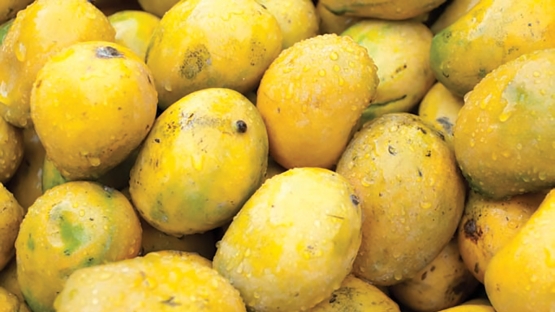An import-export door re-opened when the United States agreed to import mangoes from India after banning them for 20 years because of quarantine concerns over pest infestation and questions about pesticide use. The agreement was reached after extensive negotiations that ended when India agreed to irradiate all mango exports to the United States, thus eliminating or greatly reducing the threat of mango pests from overseas affecting USA agriculture. According to newspaper accounts when the agreement was finalized, gala parties were thrown to herald the deal. International standards that define 14 different irradiation treatments to protect plants such as mangoes from invasive pests have now been accepted by the International Plant Protection Convention. Those standards are backed up by scientific evidence gathered by the Joint FAO/IAEA Division of Nuclear Techniques in Food and Agriculture.
For well over 4000 years, the mango has been part of the cuisine and culture of India, which today is the world’s largest mango producer. Although mango is cultivated commercially in 87 countries, India alone accounts for more than half of global production. Thus, it was a cause worth noting when the USA lifted its 20-year import ban on Indian mangoes. The deal was sealed when India agreed to irradiate its mangoes before exporting them.
Irradiation calls for exposing mangoes to low doses of gamma rays that will kill any pests they may be carrying or prevent them from being able to reproduce. This is achieved without altering the taste or texture of the fruit. In the case of mangoes, there are no USA-approved chemical pesticides or treatments that can control the pests. Only irradiation has been accepted as an approved control measure. Irradiation is also used on a host of other agricultural products – fresh produce, meat, grains and spices – to kill harmful pests as well as disease-carrying bacteria, such as E coli or salmonella, and to prevent spoilage. Other treatments, such as heat, cold or chemical fungicides do not serve as well, because they can damage the food products or leave harmful chemical residues.
Interest in irradiation has grown in recent years as global food trade has increased. Because this increased trade allows more opportunities for pests and diseases to cross borders, it has led to more stringent import-export standards and quarantine requirements, as was the situation with Indian mangoes. Although individual countries set their own standards, they are usually guided by the global standards of the International Plant Protection Convention (IPPC) and the Joint FAO/WHO Codex Alimentarius Commission.



